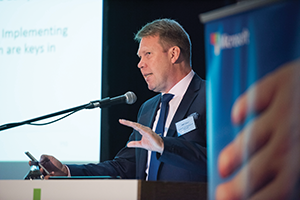Delivering digital government

Timo Valli, Chairman of the Board of Finland’s ICT centre Valtori and Director General of Finland’s Ministry of Finance, talks about the challenges of implementing an effective digital government.
Finland is recognised as a world leader in the areas of digital industry, society and government and in 2014 the World Economic Forum ranked the country first among 148 countries leveraging ICT to increase productivity, economic growth and number of quality jobs. But just how have they taken this throne and what advice would the Chairman of Finland’s ICT centre Valtori, Timo Valli give other nations trying to follow in their footsteps?
Legal framework
At present, the Finnish are attempting to digitise their entire public sector. Although regarded as a global leader in this area, Valli feels the country is really only at the starting phase of this digitisation and that there is much still to be done. The country’s e-services and e-democracy action programme was launched in 2009 and despite the success of these implementations, it soon became obvious, that in order to implement effective digital government, legislatives changes were needed.
“To make a change in the public sector as it stands currently, legislation is always required,” claimed Valli. “That’s something I learned in 2011 when I took my office in the ministry. The law is the basis for the organisation and function of the public administration and therefore if you want to change these there has to be a law.” Valli believes there is natural suspicion of something that has to be implemented by law but after discussions within parliament, amendments are made to reach an agreement and produce a legal framework with which a nation can mobilise a huge consolidation of government infrastructure.
The new law on common governmental ICT services which has been in force from the beginning of 2014, specified general legislation on public sector information governance and requires the public sector to plan to use enterprise architecture in its ICT governance and development. Thanks to this legislation Valli believes that over time, Finland will have effective public sector governance that will ensure effective integrated public administration and services.
Whilst the legal framework is an absolute necessity, Valli also stressed the importance of ensuring every department affected by the change has a shared vision objective and policies for what they wanted from their ICT systems is important. The e-services and e-democracy action plans allowed the departments the freedom to choose how to implement the e-services so the ministry’s could run their own sub-programs and choose how to implement the services. This was regarded as a positive as it gave each ministry autonomy. However, in 2009, there was very little enterprise architecture under the top level programme and this is something Valli clearly hopes will change in the coming years.
Structure
The key focus of any ICT rollout must be, Valli feels, concerned with how actual processes are changed. In his view, the implementation of a service alone is not enough, communication and education structures need to be in place so the people using the new system feel competent enough to adopt the new structures and processes.
In 2013, Finland published three national ICT strategies. The key goal of all three strategies is to improve the effectiveness of public administration services. The Organisation for Economic Co-operation and Development has suggested that three strategies are perhaps too many, but Valli feels that from a strategy development viewpoint they were all were needed. He believes the first strategy, the Public Sector ICT strategy will ensure that by 2020, services and information required by users is available, easily useable and secure. It will also ensure that cooperation of public sector organisations, businesses and users is at the leading edge of the development.
The second strategy, Valli feels is ‘sell-side’ strategy which runs parallel to the first more ‘buy-side’ strategy. The second strategy is focused on the structure and growth of Finland’s ICT industry with the ultimate goal of making Finland’s public services as friction free as possible. The third strategy deals with cyber security. This strategy is focused on minimising the threat of cyber attacks and the assessment of risk in potential developments around cloud based storage.
Policy principles
Valli is very aware that in the development of the ICT infrastructure there is policy making regulations, steering, implementation and service production and he feels that separating these roles is very important. “Of course, when dealing with the public sector there isn’t a one size fits all solution,” he said. “Ministry level cannot be directly responsible for production or implementation.
We need clearer plainer roles. For example, the Valtori agency is service production and service production only and we having discussions about consolidating a digitalisation agency to implement these policies.”
Political preference
Valli admits Finland’s public sector digital transformation has been boosted by the new government’s emphasis on it, though stressed the importance of producing a government action plan to make it clear where they are going and also called for new general legislation for the digitalisation of society as, he feels, it is important to recognise digital technologies as the new growth paradigm.
Future
Looking to the future, Valli places a great deal of importance in the public’s trust in the government and understands that in any period of change driven by a government that trust is vital to ensuring a successful transition. He is unsure how much longer the public will continue to show such trust and support for these policies but is adamant that civil servants need to remain as transparent and grounded as they can to ensure a smooth transition.
As far as developments in technology are concerned, Valli believes the importance of having an established private cloud will grow in the coming years. He believes a public sector private cloud will allow for the provision of the cloud in public sector ICT but at the same time, keep important public information stored within government infrastructure in a private and secure means.
However, Valli admits this transition could prove challenging due to the potential resistance to this change from a large number of small self-owned data centres in Finland: “We are in a situation where we have 90 data centres but we need only 10 of them, so it’s a huge number of small self-owned data centres which people have built with their own hands and so they may have lots of feelings attached to them,” Valli concluded.





